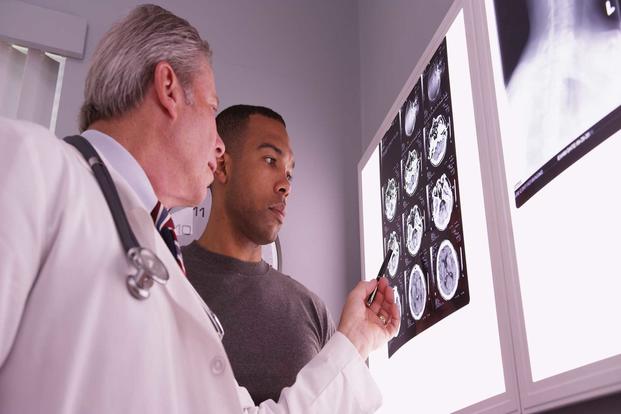- Aneurysm
- a blood-filled sac formed by disease related stretching of an artery or blood vessel.
- Anoxia
- an absence of oxygen supply to an organ's tissues leading to cell death.
- Aphasia
- difficulty understanding and/or producing spoken and written language. ( See also non-fluent aphasia.)
- Apoptosis
- cell death that occurs naturally as part of normal development, maintenance, and renewal of tissues within an organism.
- Arachnoid membrane
- one of the three membranes that cover the brain; it is between the pia mater and the dura. Collectively, these three membranes form the meninges.
- Brain death
- an irreversible cessation of measurable brain function.
- Broca's aphasia
- see non-fluent aphasia.
- Cerebrospinal fluid (CSF)
- the fluid that bathes and protects the brain and spinal cord.
- Closed head injury
- an injury that occurs when the head suddenly and violently hits an object but the object does not break through the skull.
- Coma
- a state of profound unconsciousness caused by disease, injury, or poison.
- Compressive cranial neuropathies
- degeneration of nerves in the brain caused by pressure on those nerves.
- Computed tomography (CT)
- a scan that creates a series of cross-sectional X-rays of the head and brain; also called computerized axial tomography or CAT scan.
- Concussion
- injury to the brain caused by a hard blow or violent shaking, causing a sudden and temporary impairment of brain function, such as a short loss of consciousness or disturbance of vision and equilibrium.
- Contrecoup
- a contusion caused by the shaking of the brain back and forth within the confines of the skull.
- Contusion
- distinct area of swollen brain tissue mixed with blood released from broken blood vessels.
- CSF fistula
- a tear between two of the three membranes - the dura and arachnoid membranes - that encase the brain.
- Deep vein thrombosis
- formation of a blood clot deep within a vein.
- Dementia pugilistica
- brain damage caused by cumulative and repetitive head trauma; common in career boxers.
- Depressed skull fracture
- a fracture occurring when pieces of broken skull press into the tissues of the brain.
- Diffuse axonal injury
- see shearing.
- Dysarthria
- inability or difficulty articulating words due to emotional stress, brain injury, paralysis, or spasticity of the muscles needed for speech.
- Dura
- a tough, fibrous membrane lining the brain; the outermost of the three membranes collectively called the meninges.
- Early seizures
- seizures that occur within 1 week after a traumatic brain injury.
- Epidural hematoma
- bleeding into the area between the skull and the dura.
- Erosive gastritis
- inflammation and degeneration of the tissues of the stomach.
- Fluent aphasia
- a condition in which patients display little meaning in their speech even though they speak in complete sentences. Also called Wernicke's or motor aphasia.
- Glasgow Coma Scale
- a clinical tool used to assess the degree of consciousness and neurological functioning - and therefore severity of brain injury - by testing motor responsiveness, verbal acuity, and eye opening.
- Global aphasia
- a condition in which patients suffer severe communication disabilities as a result of extensive damage to portions of the brain responsible for language.
- Hematoma
- heavy bleeding into or around the brain caused by damage to a major blood vessel in the head.
- Hemorrhagic stroke
- stroke caused by bleeding out of one of the major arteries leading to the brain.
- Hypermetabolism
- a condition in which the body produces too much heat energy.
- Hypothyroidism
- decreased production of thyroid hormone leading to low metabolic rate, weight gain, chronic drowsiness, dry skin and hair, and/or fluid accumulation and retention in connective tissues.
- Hypoxia
- decreased oxygen levels in an organ, such as the brain; less severe than anoxia.
- Immediate seizures
- seizures that occur within 24 hours of a traumatic brain injury.
- Intracerebral hematoma
- bleeding within the brain caused by damage to a major blood vessel.
- Intracranial pressure
- buildup of pressure in the brain as a result of injury.
- Ischemic stroke
- stroke caused by the formation of a clot that blocks blood flow through an artery to the brain.
- Locked-in syndrome
- a condition in which a patient is aware and awake, but cannot move or communicate due to complete paralysis of the body.
- Magnetic resonance imaging (MRI)
- a noninvasive diagnostic technique that uses magnetic fields to detect subtle changes in brain tissue.
- Meningitis
- inflammation of the three membranes that envelop the brain and spinal cord, collectively known as the meninges; the meninges include the dura, pia mater, and arachnoid.
- Motor aphasia
- see non-fluent aphasia.
- Neural stem cells
- cells found only in adult neural tissue that can develop into several different cell types in the central nervous system.
- Neuroexcitation
- the electrical activation of cells in the brain; neuroexcitation is part of the normal functioning of the brain or can also be the result of abnormal activity related to an injury.
- Neuron
- a nerve cell that is one of the main functional cells of the brain and nervous system.
- Neurotransmitters
- chemicals that transmit nerve signals from one neuron to another.
- Non-fluent aphasia
- a condition in which patients have trouble recalling words and speaking in complete sentences. Also called Broca's or motor aphasia.
- Oligodendrocytes
- a type of support cell in the brain that produces myelin, the fatty sheath that surrounds and insulates axons.
- Penetrating head injury
- a brain injury in which an object pierces the skull and enters the brain tissue.
- Penetrating skull fracture
- a brain injury in which an object pierces the skull and injures brain tissue.
- Persistent vegetative state
- an ongoing state of severely impaired consciousness, in which the patient is incapable of voluntary motion.
- Plasticity
- ability of the brain to adapt to deficits and injury.
- Pneumocephalus
- a condition in which air or gas is trapped within the intracranial cavity.
- Post-concussion syndrome (PCS)
- a complex, poorly understood problem that may cause headache after head injury; in most cases, patients cannot remember the event that caused the concussion and a variable period of time prior to the injury.
- Post-traumatic amnesia (PTA)
- a state of acute confusion due to a traumatic brain injury, marked by difficulty with perception, thinking, remembering, and concentration; during this acute stage, patients often cannot form new memories.
- Post-traumatic dementia
- a condition marked by mental deterioration and emotional apathy following trauma.
- Post-traumatic epilepsy
- recurrent seizures occurring more than 1 week after a traumatic brain injury.
- Prosodic dysfunction
- problems with speech intonation or inflection.
- Pruning
- process whereby an injury destroys an important neural network in children, and another less useful neural network that would have eventually died takes over the responsibilities of the damaged network.
- Seizures
- abnormal activity of nerve cells in the brain causing strange sensations, emotions, and behavior, or sometimes convulsions, muscle spasms, and loss of consciousness.
- Sensory aphasia
- see fluent aphasia.
- Shaken baby syndrome
- a severe form of head injury that occurs when an infant or small child is shaken forcibly enough to cause the brain to bounce against the skull; the degree of brain damage depends on the extent and duration of the shaking. Minor symptoms include irritability, lethargy, tremors, or vomiting; major symptoms include seizures, coma, stupor, or death.
- Shearing (or diffuse axonal injury)
- damage to individual neurons resulting in disruption of neural networks and the breakdown of overall communication among neurons in the brain.
- Stupor
- a state of impaired consciousness in which the patient is unresponsive but can be aroused briefly by a strong stimulus.
- Ubdural hematoma
- bleeding confined to the area between the dura and the arachnoid membranes.
- Subdural hygroma
- a buildup of protein rich fluid in the area between the dura and the arachnoid membranes, usually caused by a tear in the arachnoid membrane.
- Syndrome of inappropriate secretion of antidiuretic hormone (SIADH)
- a condition in which excessive secretion of antidiuretic hormone leads to a sodium deficiency in the blood and abnormally concentrated urine; symptoms include weakness, lethargy, confusion, coma, seizures, or death if left untreated.
- Thrombosis or thrombus
- the formation of a blood clot at the site of an injury.
- Vasospasm
- exaggerated, persistent contraction of the walls of a blood vessel.
- Vegetative state
- a condition in which patients are unconscious and unaware of their surroundings, but continue to have a sleep/wake cycle and can have periods of alertness.
- Ventriculostomy
- a surgical procedure that drains cerebrospinal fluid from the brain by creating an opening in one of the small cavities called ventricles.
- Wernicke's aphasia
- see fluent aphasia.
Stay on Top of Your Military Benefits
Not sure what your veteran health care benefits are? Keep up with all the changes and details. Subscribe to Military.com. and get all the latest updates straight to your inbox.










